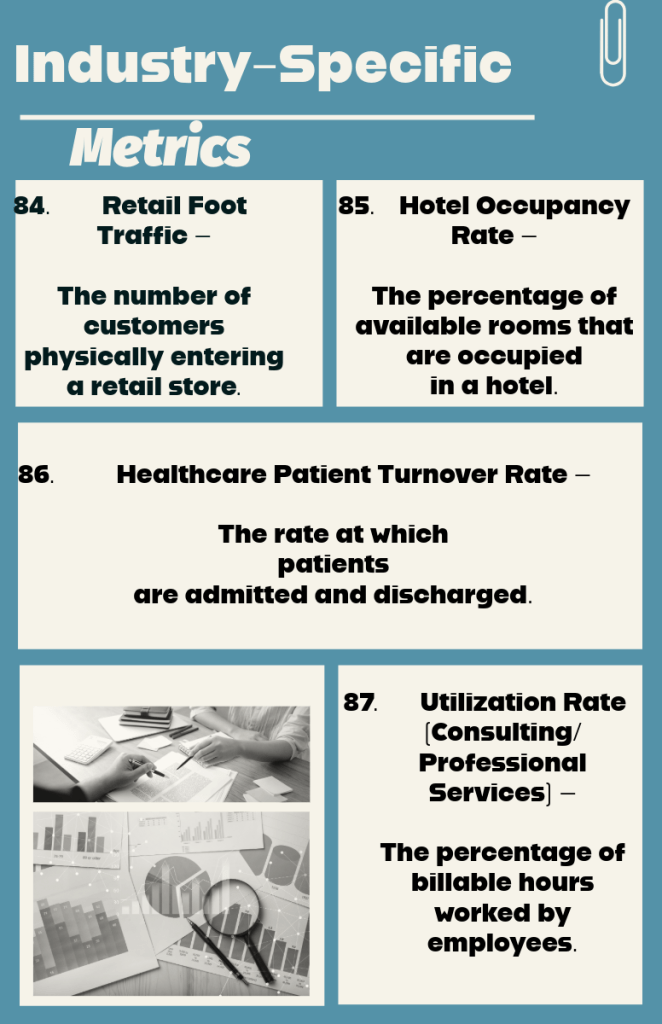
Business metrics, or key performance indicators (KPIs), are essential for tracking a company’s performance and ensuring it stays on track to achieve its goals. Creating a comprehensive guide on the “87 Business Metrics Your Company Needs to Know” can be a valuable resource for entrepreneurs and business leaders looking to optimize performance.
If you have a successful company, you will get your market share. But to get a successful company, what do you have to have? The same metrics of success that your customer does.
Here’s a structured approach, categorized by key areas such as finance, sales, marketing, customer service, product/development, human resources, operations, growth & innovation, and industry-specific metrics. Each metric should include a brief description and how it impacts business success.
1. Financial Metrics
Financial metrics are key indicators used to assess a company’s financial health, performance, and profitability, such as revenue, net income, and return on investment (ROI). These metrics help stakeholders make informed decisions by analyzing aspects like liquidity, efficiency, and growth potential.

2. Marketing Metrics
Marketing metrics are quantitative measures used to evaluate the effectiveness of marketing efforts, including metrics like customer acquisition cost (CAC), conversion rates, and return on marketing investment (ROMI). They help businesses track performance, optimize campaigns, and make data-driven decisions to improve overall marketing outcomes.

3. Sales Metrics
Sales metrics are performance indicators that measure the effectiveness of a company’s sales efforts, such as lead conversion rate, average deal size, and sales cycle length. These metrics help businesses track sales performance, identify areas for improvement, and set data-driven sales strategies.
You’ve got to tell a story, paint a vision, know your metrics and sell, sell, sell.

4. Customer Success Metrics
Customer success metrics measure the effectiveness of efforts to ensure customers achieve their desired outcomes, focusing on metrics like customer retention rate, Net Promoter Score (NPS), and churn rate. These metrics help businesses understand customer satisfaction, loyalty, and overall product or service value to drive long-term success.

5. Product/Development Metrics
Product or development metrics assess the performance and progress of a product’s development lifecycle, focusing on metrics like time to market, feature adoption rate, and defect density. These metrics help teams track efficiency, product quality, and user satisfaction, enabling continuous improvement and innovation.

6. Operational Metrics
Operational metrics are indicators that measure the efficiency and performance of a company’s day-to-day processes, such as production efficiency, inventory turnover, and order fulfillment time. These metrics help organizations optimize operations, reduce costs, and ensure smooth and effective business workflows.

7. Human Resources Metrics
Human resources metrics are key indicators that measure the effectiveness of HR functions, such as employee turnover rate, time to hire, and employee engagement levels. These metrics help organizations assess workforce productivity, retention, and the overall impact of HR practices on business outcomes.

8. Growth & Innovation Metrics
Growth and innovation metrics assess a company’s ability to expand and innovate, focusing on indicators like revenue growth rate, market share, and the percentage of revenue from new products or services. These metrics help track the effectiveness of innovation strategies and a company’s ability to stay competitive and drive sustainable growth.

9. Industry-Specific Metrics
Industry-specific metrics are tailored performance indicators that reflect the unique aspects of a particular industry, such as occupancy rates in hospitality, same-store sales in retail, or loan default rates in banking. These metrics provide businesses with insights that align with industry standards, helping them measure success and benchmark against competitors.

Final Thoughts
Understanding and tracking these metrics can significantly improve decision-making and business performance. The key is not to get overwhelmed but to prioritize metrics that align with your company’s goals.
Check out more business articles here
